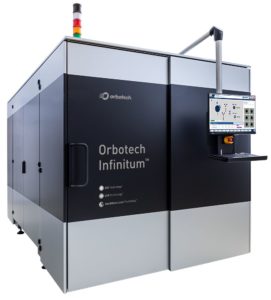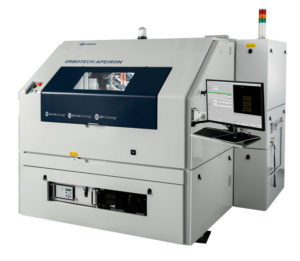Orbotech’s Infinitum 10/10XT writes directly on flexible PCB resist to produce circuit images while the Apeiron system uses lasers to drill via holes.
With all the talk about 5G radios and wireline networks, it’s easy to forget that all the components either attach to or are connected by flexible and rigid printed-circuit boards (PCBs). Unless, of course, you’re responsible for designing or manufacturing those circuits. While rigid PCBs must be manufactured entirely on panels, flex circuits can be produced from rolls of copper. Orbotech has introduced two machines that use lasers to form circuit images and to “drill” via holes. Many of today’s circuits have lines too fine and spacings too small for traditional production methods.
When I was in high school, I worked afternoons for a manufacturer of flex circuits. Back then, flex circuits were “panelized” similar to rigid PCBs. Let’s assume a single-sided circuit for simplicity. The copper substrate had an insulating backing, and the exposed side would get coated with a photosensitive resist. A mask containing the circuit’s image would impose the image on the resist. An etching process would then remove the unwanted copper, leaving the circuit. When vias were needed, a drilling machine would drill them through several layers of the “panels” stacked up on each other.
Because today’s circuit are so much more complex than they were at that time and factory floor space much more expensive, flex circuits are now fabricated on rolls instead of sheets that were manually cut. Instead of shooting a circuit image into the copper’s photosensitive material, Orbotech’s Infinitum 10/10XT series uses a programmable laser to expose the photosensitive material at the proper locations. The video below shows how the Infinitum’s lasers operate as the copper rolls by, a process called “Drum Direct Imaging,” all within a 3.4 m × 2 m footprint.
The Infinitum can produce lines and spaces between them (line/space, L/S) at distance as small as 10 µm and 15 µm, respectively. It’s registration accuracy (feature-to-Grid, FTG) is ±10µm. Running for 24 hours, the Infinitum can write images on 2400 m to 2700 m of copper.
Flex circuits also need holes drilled in them that become vias for connecting traces through the material or for installing components. While the traditional way to do that was to align multiple sheets and drill through them, Orbotech’s Apeiron system “drills” holes through the PCB material using lasers. It uses mirrors to create four lasers from one source and directs them onto the roll or panel.
Each of the drilling lasers has a working area of 65 mm × 65 mm. It supports simultaneous drilling of two 260 mm sheets placed side-by-side. The machine’s precise measurement tools provide accurate drilling position while laser-beam monitoring tools ensure high drilling quality with optimal beam.



